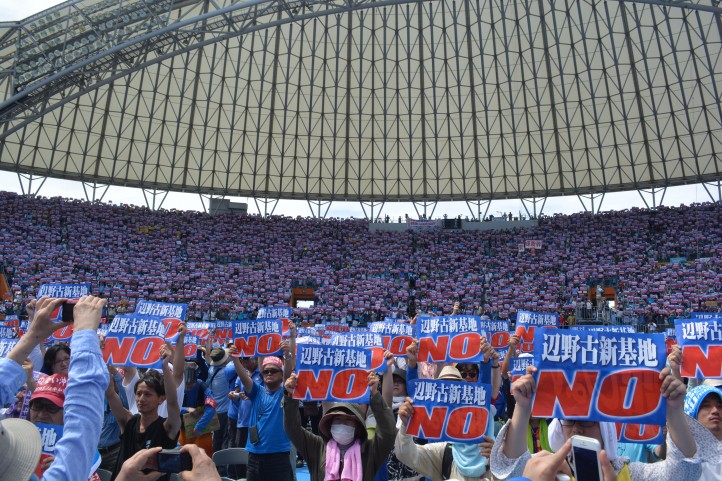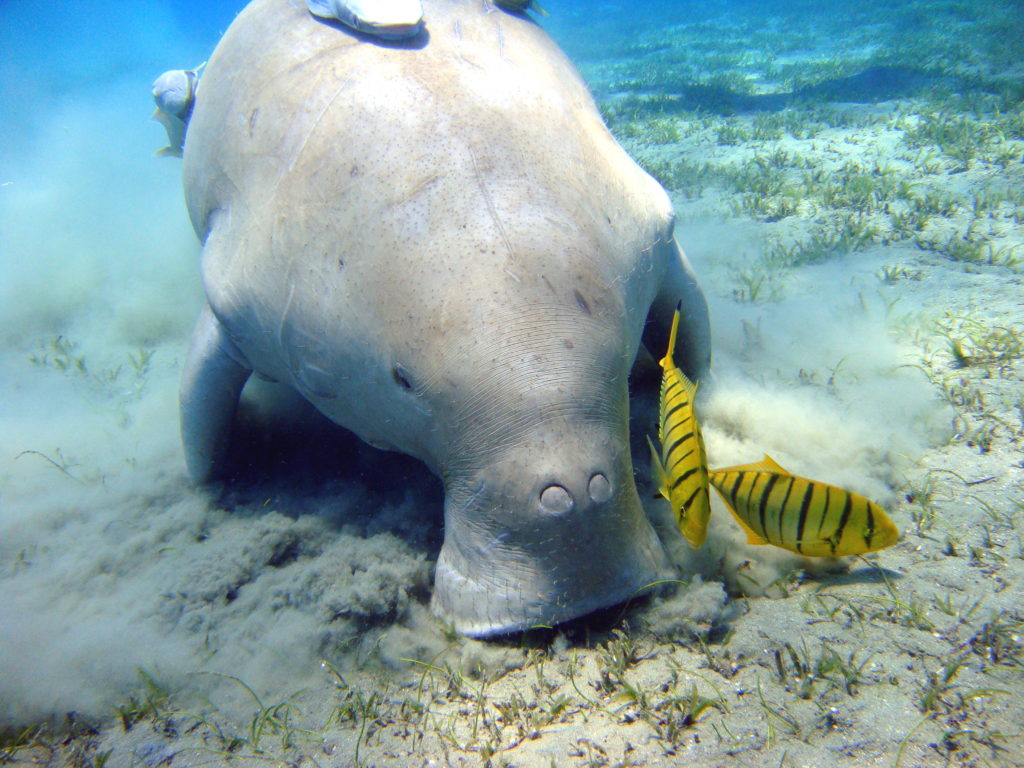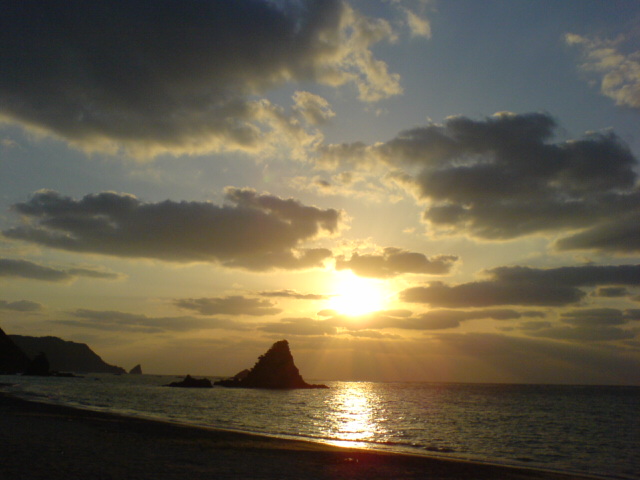
“Our forebears, who have long fought this battle, taught us that no matter how many times we are pushed down, we must get back on our feet once again and raise our voices: “We don’t want any military bases!” – Statement made on December 14th 2018 by Okinawa’s canoe team, who are dedicated to protecting Oura Bay from US base construction.
The US army’s occupation of the island of Okinawa began in 1945. It has never ended, despite the island officially returning to Japanese rule in 1972. US bases – housing 26,000 Marines – occupy a massive 15.3% of the land on the island.
Right now, new US base construction at Henoko is causing massive ecological destruction to the beautiful Oura Bay. Despite daily mass acts of direct action, a landfill operation is being pushed through in Oura Bay to make way for a military runway, with devastating consequences for the Bay’s marine life. The runway is being built literally on top of a beautiful coral reef, which houses a unique ecosystem.
The construction is being backed and bankrolled by Japan’s pro-US right-wing government, headed by Shinzo Abe. Abe, like most of the Japanese post-war leaders that came before him, sees Japan’s reliance on US militarism as necessary for the success of Japanese capitalism. Furthermore, Abe hopes that making Japan essential to US foreign policy in the region will secure US backing for his long-term goal of changing the Japanese constitution to allow Japan to become an independent military power by relaxing post World War Two restrictions on Japanese militarism. This strategy means that the Japanese government will facilitate the expansion of US bases on Japanese territory at all costs.
Attempts by Okinawan people to oppose the base construction through the Japanese political system have been repeatedly undermined by the central government. This year, Okinawans elected anti-base politician Denny Tamaki as Governor of Okinawa prefecture. The prefecture withdrew its support for the land reclamation scheme necessary for the runway. Work stopped for three and a half months, but preparations have restarted after the central government intervened on October 30th. Governor Tamaki called the central government’s action “illegal”, and went on to say, “I cannot fathom that this is an act of a constitutional nation.” Similarly, in 2015, Takeshi Onaga, who was then Okinawan governor, tried to prevent the construction, the central government overrode his order within three days.
However, the prefectural government’s opposition did have some effect. In late December 2018, it was announced that the seawall around Oura Bay now cannot be completed until 2020 because of the delay. It has given a little more breathing space for social movements to organize to resist the project.
Preparations for the landfill operation have been ongoing since early 2017. However, work on the irreversible phase of the land reclamation in Oura bay started on December 14th. Local people, and their supporters from all over Japan, are organizing direct action against it. Okinawans are also calling for people to sign a petition to the White House, demanding that the work ends until a referendum about the project, called for Febuary 24th 2019 by Governor Tamaki, can be held in Okinawa.
Every day, hundreds of protesters gather for a sit-in outside Camp Schwab’s gates. Many of them are elderly people who remember the initial US occupation of the island. It was at one of the sit-ins, while we were visiting the island, that we met with ecological activists Masako Suzuki and Etsuko Urashima.

Masako and Etsuko are activists campaigning about the effect of the construction of the military runway on the island’s vulnerable dugong population. The dugong, sometimes called a sea cow, is highly endangered globally, and considered critically endangered on Okinawa. Okinawa is the marine mammal’s northern-most global habitat.
Masako first heard about the danger to the marine life in Oura Bay when she was living in Tokyo. At the time she was working with a group called the Association for the Northern-Most Dugong. She began to research the plans for the runway in Henoko, and to study the impact that it would have on the island’s dugongs. In 2006, she decided to move to Okinawa to become more involved in conservation. There, together with Etsuko, she formed the ‘Team Zan’ research team.
‘Zan’ means ‘dugong’ in the Okinawan language. Masako tells us that dugongs are important in Okinawan culture, traditionally thought of as messengers from the gods.
As the government’s plans for the new military runway progressed, aerial photographs were released by the media, showing the presence of dugongs in Oura bay feeding on sea grass. Team Zan began monitoring the dugongs, and identified at least three.
From 2004, when the preparatory boring for the US military runway began in the bay, and Oura became a battleground between Japanese government contractors and sea-bound protesters paddling on kayaks, the dugongs fled. From that time, only one of the three identified dugongs is thought to have returned to sea-grasses near to the construction area. Now that construction in the Bay is underway, there have been no recent sightings of any dugongs in the area.
Team Zan has found that the dugongs are increasingly feeding from sea-grass trenches elsewhere on the island, but sea-grass beds are scarce and the runway construction is making their existence ever more precarious. The constant struggle to find new food sources makes it ever more likely that the dugongs will move into fishing areas and be caught in nets.
By the time work had begun in 2004, a coalition of activists and conservation NGOs had already begun planning to take the Department of Defence (DoD) to court in the US to protect the dugongs. The first victory came in 2008, when a US federal court in San Francisco ruled that the US DoD’s construction plans violated the National Historic Preservation Act by not protecting the dugongs, which are a Japanese ‘national monument.’ The court ruled that the impacts of the project must be considered in order to mitigate harm.
“Dugongs are very much in danger here. But the Japanese government doesn’t do anything to protect them,” Masako explained. “In Japan the dugong is considered a national treasure, but there’s no law to protect national treasures. People have demanded that the government protect the dugong in law, but the government doesn’t accept that. Other endangered animals are protected in law, but the dugong is excluded because of the US military construction plans.”
After the Obama administration made it clear that it planned to support the Henoko base plans, a lawsuit was filed challenging them. Many years of court battles ensued.
In August 2018 the US District Court dismissed the claims on behalf of the dugong, ruling that it was only necessary for the DoD to conduct its own internal assessments of the impact of the base construction.
In September, an appeal was lodged against the district court’s ruling. “This could be the last chance to save the dugong. The court should compel the US military to follow the law and not wipe out these amazing animals,” said Peter Galvin, co-founder of the Center for Biological Diversity, one of the plaintiffs in the court case against the Oura Bay construction.
But the battle is not only for the dugongs. Etsuko tells us, “it’s important to protect not only dugongs but the whole area. There is a rare ecosystem here in Henoko, where ocean, rivers and forest meet.”

Masako continues, “researchers found that the ecosystem here in Oura Bay is part of a very ancient environment from when the islands and the [Japanese] mainland were connected. This ecosystem is thought to only still exist in the area around Oura Bay.”
This diversity is illustrated by the fact that in 2009, a survey of crustaceans living in Oura Bay found more than 30 previously unknown species.
According to Etsuko, “the sea landscape here is very complex, there’s a lot of diversity. There are over 5,000 species here, 262 of which are endangered. When the runway construction fills the sea, all the creatures will be destroyed.”
A few day later, Masako takes us out into the bay in a glass bottomed boat that her son operates for tourists. She says she wants us to see the beauty of the bay. We see hundreds of fish, from many species, congregating over a huge mass of coral. Masako tells us that this is the one of the world’s biggest colonies of endangered blue coral, believed to be 3,000 years old, and growing by just one centimetre per year. “If it is damaged it will take a long time to repair itself.”
The area that we visit on the boat is just outside of the construction area, which is now out of bounds to local people, but Masako and other ecologists are worried that the runway construction will affect a much wider area. Oura Bay is at the mouth of a river, and the ecosystem relies on the currents created to nurture unique forms of life and facilitate the spawning of new coral. Local people are certain that the ten meter high runway walls will disrupt this fragile environment. They are also worried about chemical pollution from construction machinery and large military boats.
Of course, the resistance against US bases in Okinawa isn’t only an ecological struggle. Local people we interviewed in Okinawa said they were opposed to the US bases for a long list of reasons. For example, some were against the bases because they were originally built on land forcibly taken from Okinawan people, or because the tens of thousands of US marines on the island have been responsible for violence, murder, and rape. Others were struggling against the base expansion because they were angry that the Japanese government is forcing the base construction on people in Okinawa to further its own political aims. Still others do not want to be complicit in the US’s unending imperialist wars. The ecological struggle to save the dugongs, and the unique eco-system in Oura bay, needs to be understood in the context of these intersecting struggles.
The Okinawan struggle against US bases also needs to be understood as part of a wider international struggle against US imperialism in the Pacific region. The US is maintaining a ring of military bases, many of them nuclear, across the Pacific region encircling China, its main economic rival. This policy is designed to cement US military and economic domination in the Pacific. (To find out more about these policies, watch John Pilger’s recent film, The Coming War on China.
The Okinawan anti-base resisters are networked with those resisting US bases on the Japanese mainland, in Australia, and in South Korea. During our visit to the island, a delegation from a South Korean leftist party had come to join the sit-in at Camp Schwab, while in 2016 members of the Okinawan anti-militarist movement had joined a convergence against Pine Gap in Alice Springs, Central Australia. In 2017, delegations from both the Okinawan and South Korean anti-base movements travelled to the UK to take part in the War Resisters International conference, and join the struggle against DSEI, the world’s biggest arms fair held in East London.
The ecological struggle for Oura Bay, its fishes and coral, and for Okinawa’s dugongs, rely on the success of these movements.
The petition to the White House calling for a halt to the work in Oura bay until a referendum can be held is here.
The Center for Biological Diversity’s petition to save the Okinawa Dugong is here.
Here is a list of some of the Japanese websites with information about the protests in Okinawa:
https://henokoblue.wordpress.com/ – The blog of the kayak team monitoring the base in Henoko.
http://takae.ti-da.net – For info about the movement against helipad construction in Takae, in the North of Okinawa.
http://apjjf.org/ – Has some interesting articles in English about Okinawa.
Tom Anderson is part of Shoal Collective, a newly formed cooperative of writers and researchers writing for social justice and a world beyond capitalism. Twitter: @shoalcollective
Many thanks to Eliza Egret for her help with the interviews and research for this article and to Saku Furumachi for her excellent translation.
